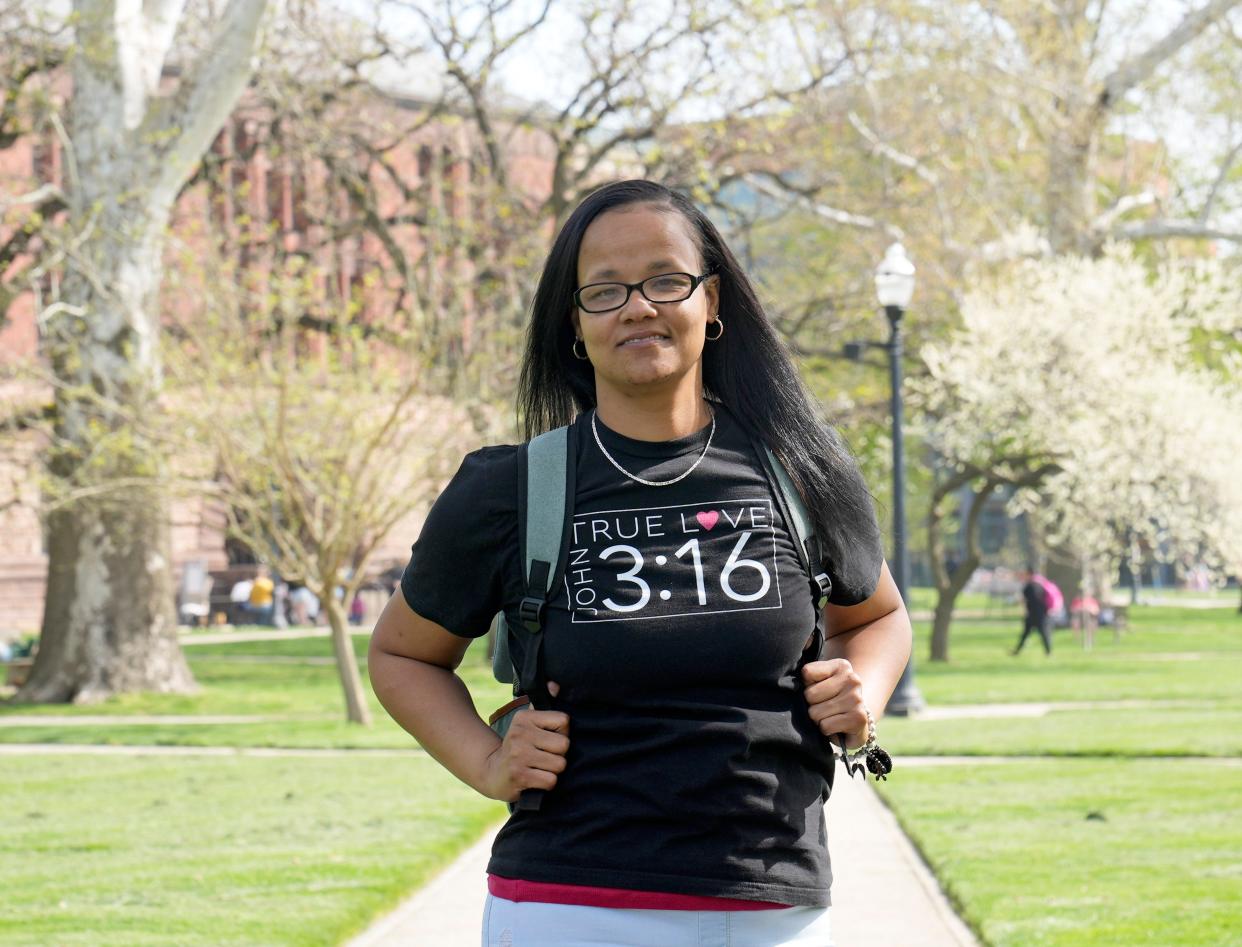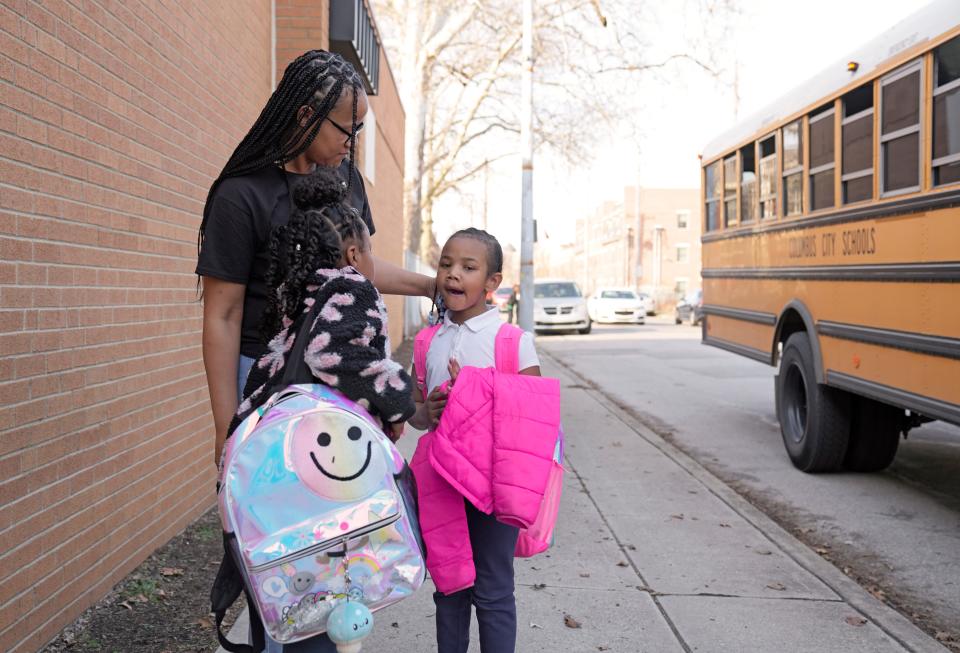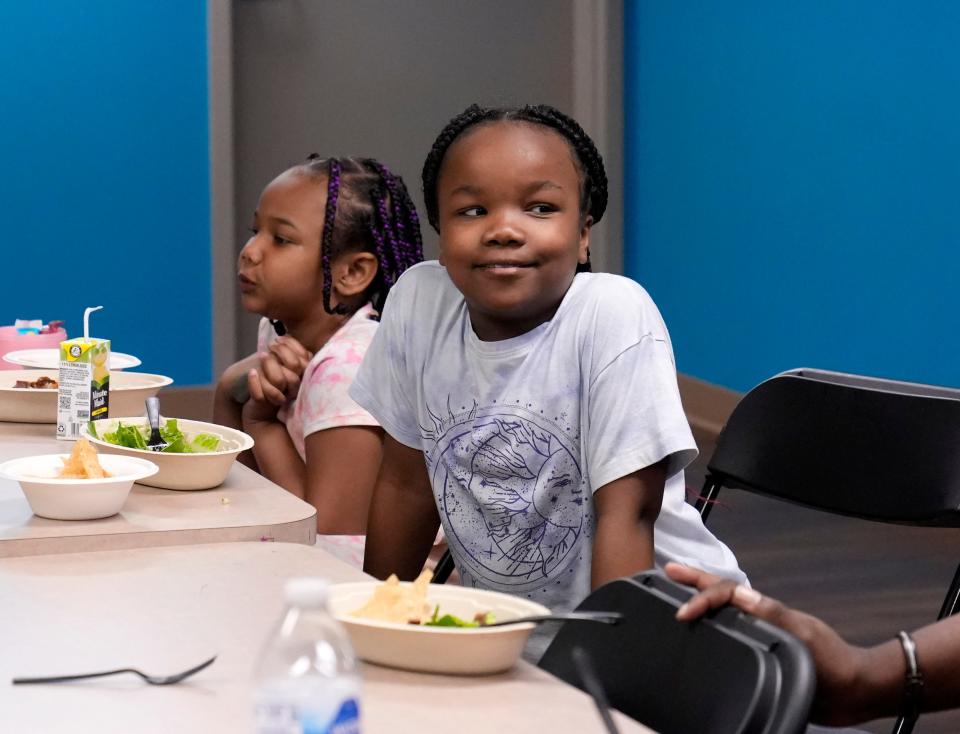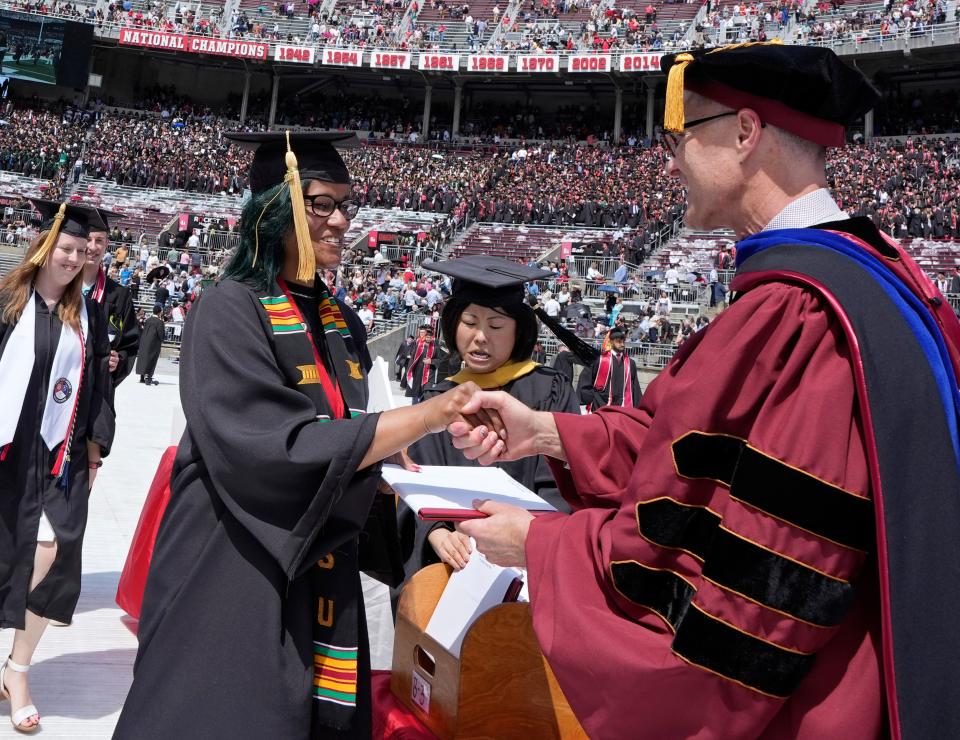'One degree at a time': Columbus Scholar House helps get student parents through college

Three days a week, Nikia Gales parks her car at Ohio Stadium and walks up Annie and John Glenn Avenue to her classes at Stillman Hall. All the while, she soaks in the scenes of college life around her.
Gales, a 45-year-old single mother, never envisioned herself walking across Ohio State University’s campus, let alone being enrolled as a student.
In August 2018, Gales decided to try one last time to get a college degree. She quit her full-time job and made school her top priority, but her part-time job wasn’t bringing in enough to break even. Bills started piling up, and Gales fell a month-and-a-half behind on rent.
Her options were dwindling and eviction was imminent when she learned about Columbus Scholar House, a housing program for low-income custodial parents trying to get a college degree.
Where colleges fall short of providing housing-insecure students with affordable places to live, programs like Scholar House are one solution to help students like Gales, who want to go to college and increase their earning power but face basic needs insecurity trying to get there.
Scholar House is a housing tax credit development for student parents run through a collaboration between Ohio Capital Corporation for Housing, Columbus Metropolitan Housing Authority, the Affordable Housing Trust of Columbus and Franklin County and Ohio State.
Residents must be low-income, the custodial parent of at least one child, and be enrolled in a degree-seeking program at an accredited college or university. Residents are qualified for a Section 8 project-based voucher to offset their housing costs, as well as on-site child care through a partnership with the YMCA of Central Ohio.
Student parents receive housing and other support services that help them overcome barriers and complete their degree.
Gales, now a five-year Scholar House resident, is keenly aware of what life would’ve been like without that lifeline.
“If Scholar House was not there, that immediate crisis would have been homelessness,” Gales said. “I wouldn’t have been out on the street or in my car. I would have been in my mom’s home, but that would have stressed me because I know I’m stressing her out.”
Gales had tried college before. She'd been a student at Columbus State Community College, as well as online programs with University of Phoenix and Grand Canyon University, but never more than a few semesters at each school. She used up all of her free federal student aid and took out the maximum amount of student loans to pay for everything. Something always came up that forced her to drop out.
She hadn’t needed a college degree when she was raising her three eldest daughters, but with her two youngest girls, Payton and Skylar, still at home and her 40th birthday on the horizon, Gales decided it was time.
There was a problem though. Her job, a non-degree caseworker at the Breathing Association earning $20 an hour, was grant-funded, so it wasn’t possible for her to work part-time. She would have to fit school around her career or quit and commit everything to getting that degree.
Gales had made up her mind. Her coworkers prayed with her in the parking lot, she turned in her two-weeks' notice and enrolled at Columbus State once more.
Two months later, her father, Steven, died unexpectedly. Her relationship with her girls’ father was on the rocks and by June 2019, Gales had asked her partner to move out. But the price for that peace of mind created a new set of stressors. What was two people splitting $675 a month rent now solely rested on Gales’ shoulders.

Without Scholar House, college would’ve been put on the back burner again.
“I would have had to go right back to work, and I don’t know what that would have looked like because I wouldn’t have been able to go back to my job without a degree and with all that hard work,” Gales said.
“It would have been a dark road, I would have had a lot of regrets if I went that way,” she added. “I would have been mad at myself. Why did you think you could do this?”
The risk paid off. After graduating from Columbus State in 2021, Gales began working towards her bachelor’s degree in social work at Ohio State, all while living at the Scholar House.
'They are landlords'
A report published in March by the Annie E. Casey Foundation said that an estimated 3.5 million young adults ages 18 to 25 experience housing insecurity and homelessness in some way in a given year. According to the Baltimore-based youth welfare nonprofit, they’re sleeping in cars, couch-surfing and, in the most extreme circumstances, in shelters or on the streets.
Tens of thousands of those young adults are attempting to get college degrees and find stable housing at the same time, according to a 2020 survey by The Hope Center for College, Community and Justice at Temple University in Philadelphia.
Housing insecurity and homelessness among college students has become a more visible issue across higher education in the last few years. The COVID-19 pandemic highlighted just how tenuous a student’s housing situation can be, and how many are just a couple financial missteps away from homelessness.
But unlike K-12 school districts, which are mandated by the federal McKinney–Vento Homeless Assistance Act to enroll and educate all students regardless of living situation, university leaders aren’t required by federal or state laws to report student homelessness on their campuses. Because of this, many schools underestimate how common housing insecurity is among their students.
Therein lies the irony, said Jennifer Erb-Downward, director of housing stability programs and policy initiatives at the University of Michigan’s Poverty Solutions. College campuses are much better equipped to help house students than K-12 districts, she said, which more often resemble small towns complete with access to housing, dining, health care and other services.

“I definitely think that colleges have more of a resource base to help students who are experiencing housing instability and homelessness,” Erb-Downward said. “Right now, the system is not structured to do so. But if that university wanted to, they are landlords. They have dorms.”
Bryce McKibben, senior director of policy at The Hope Center, said colleges have a real opportunity to create an ecosystem that supports all students, regardless of their housing situation.
“Campuses that are the most successful are those who’ve connected the dots between disparate parts of a campus that can be siloed,” he said. “Is the housing department separate from the business office, and are they separate from the financial aid officers? Only when colleges bring those together and offices are talking to each other can this work.”
What are Ohio’s colleges doing for housing insecure students?
Services to help housing insecure students in Ohio vary by college and university.
Of the state’s 14 public universities, four explicitly offer temporary housing for their students in crisis, like eviction or unsafe living conditions. They are the University of Akron, University of Cincinnati, Kent State University and Ohio University.
Most, like Ohio State, offer emergency assistance grants to help pay for rent and bills, typically between $500 to $1,000. Others acknowledge that homelessness is an issue and offer a phone number for struggling students to call for help, but don’t say specifically on their websites what services they offer. A couple of schools don’t advertise any official assistance to help during a housing crisis.
That’s not uncommon, said Barbara Duffield, executive director of the SchoolHouse Connection, a Washington, D.C.-based national nonprofit working to overcome student homelessness through education.

“A lot of it is piecemeal,” she said.
Some of that is because schools have different resources and populations they serve.
Community colleges, for instance, historically report more students dealing with housing insecurity than four-year institutions. That is partly because community colleges more often serve nontraditional and low-income students, many of whom are working full-time or supporting families while they’re in school.
But the vast majority of community colleges do not have dorms or other on-campus housing for students. Of Ohio’s 23 two-year colleges, only one has residential housing for students: Hocking College.
But Duffield said she thinks a big reason more colleges aren’t equipped to serve housing insecure students is because they don't know what they don't know.
“It's contingent on people being aware. It usually requires somebody who's really leading the charge locally, or an advocacy organization that's really pushing the issues,” she said.
“You see just very piecemeal, fragmented efforts. But they're there. There are people who are doing something about it. It's not like nothing's happening. It's just not enough.”
Ohio State, for instance, does not have emergency housing for students experiencing housing insecurity, said Kimberly Pachell, director of the university’s Student Advocacy Center. The university used to have rooms available for housing-insecure students at Buckeye Village, an affordable housing complex for students with families and graduate students. But those properties were demolished last year.
Instead, the university now has an option for a short-term housing stay in a residence hall for a few days — but that’s only if there is room available, she said.
“If we're at capacity, that, unfortunately, is not an option for us,” Pachell said.
Ohio State students can apply for a one-time $1,000 in emergency funding through the university’s Student Advocacy Center, Pachell said. When it comes to housing insecurity, she said the advocacy center takes a holistic approach.
“We don't just look at the homelessness issue, we really want to dive a little deeper,” she said. “We also realized that we can't solve everything or that we can't solve everything all at once. But how do we create that plan to help them move forward?” Kimberly Pachell, director of the university’s Student Advocacy Center
About a dozen students at the University of Akron experience some kind of housing crisis each year, said Melinda Grove, the university’s director of student life and housing. In addition to emergency assistance grants, the University of Akron offers temporary housing for students in one of its residence halls.
ZipAssist, a university resource hub for students, can have a room ready for a student within a couple hours — complete with a bag of groceries, snacks, hygiene items, sheets, towels, a pillow and bedding. The university currently has four rooms earmarked for such emergencies.
Students can stay in those dorms for up to 33 days while they work with ZipAssist to get into more stable housing.
“Empowerment is a big word in a lot of things that we do and a lot of the resources that we provide,” said Anna Ball, associate director of ZipAssist. “We want to be able to empower students and individuals to see what is the next step … What we want for them is to have secure housing.”
The University of Akron's temporary housing program is so appreciated that it's moving to a larger space this fall with more rooms for students.
Some community colleges have tried their hand at residential housing for students in need.
Columbus State Community College introduced the Success Bridge Housing Stabilization program in September 2020 to support students experiencing housing instability. It was a partnership between the college, the Affordable Housing Alliance of Central Ohio, Columbus Metropolitan Housing Authority, Homeless Families Foundation and the Community Shelter Board.

The three-year pilot program provided campus, career and community resources to students actively pursuing a degree, namely with subsidized housing. It also included assistance for students facing homelessness, for past-due rent payments and past-due utility bills.
The housing program was two-fold: It offered up to four months of short-term assistance for those in an urgent housing crisis, and mid-term assistance for up to 28 months to get students through college by placing them in housing through the community partners.
Thirty-four students went through the pilot with mixed success, said Lisa Phillips, Columbus State’s administrator for student advocacy and financial stability. Many graduated, but others left college for other opportunities, typically a decent-paying job that don't require degrees.
With the pilot now over, Phillips said she isn’t sure what’s next, or if Columbus State will try out other residential housing programs. One thing is certain, she said: “Housing is so essential.”
‘Breaking the cycle of poverty one degree at a time’
Behind the bright yellow door of Gales’ brick townhome are walls meant to inspire.
Between the countless family photos, affirmations and Bible verses, every one of her pale yellow walls is spoken for. Gales wants her home to be a sanctuary for her and her girls — a place where they know they belong.
One list of statements, written on a simple sheet of white paper and tacked by the kitchen, has been one of Gales’ mantras for months: I am chosen. I am capable. I am a child of God. I can. I will. End of story.
Gales and her two youngest daughters — Payton, 9, and Skylar, 6 — moved into the Scholar House in January 2020. After being unable to pay rent for the last two months at their previous apartment, Gales and her girls moved in with her mom for a couple of weeks in between houses. Bunking up with her mom and the nieces, nephews and grandchildren she cares for, Gales got a taste of what her future could’ve held.
Moving into the Scholar House, she said, was like that first inhale after holding your breath for too long.
“I thought, ‘I don't have to worry about housing. Housing is not on my plate no more.’ That alone was a huge relief,” Gales said.
Scholar House is about more than just housing though.
“My motto is ‘Breaking the cycle of poverty one degree at a time,’” said Traci Lewis, director of the ACCESS Collaborative program at Ohio State, which provides programming for Scholar House residents and their children.
Lewis and a slew of other social workers, master’s students, counselors, mentors and volunteers work with the residents and their children. About a dozen women currently live in Scholar House residences (though the program is not specifically for mothers, the vast majority of custodial parents are women,) which are located in several complexes on the Near East Side.
Most of the residents attend local colleges such as Ohio State, Columbus State, Capital University and Ohio Dominican University, although Lewis has known a few to attend online programs. They study nursing, social work, education, computer science and engineering. Some have gone on to be lawyers and earn their Ph.Ds.
On top of academic and social supports, Scholar House residents also take part in programming offered through Lewis’ office. On a recent April evening, in a brick building just down the block from their townhouse, Gales and the girls chowed down on Chipotle burrito bowls with the other residents and their kids.
This would be their last session together for the semester before some of the women would finally be graduating from college and the Scholar House.

The kids split up from their moms and went into a side room with Z.F. Taylor, known by everyone as Mr. Z, who partners with Ohio State to offer mentorship programming.
For the last few months, each of the kids created a vision board that they were going to present to their families the following week. Payton held up a yellow poster with clippings from beauty and travel magazines, symbolizing her dream to become a fashion designer. Skylar wants to be a chef one day, as demonstrated by her pink poster board covered with pictures of her favorite foods.
The projects were a chance for the kids to envision their future selves, Taylor said.
“Go ahead and put those plans in motion,” he said. “There is a tomorrow.”

Taylor, who has been a mentor for three decades, said working with Scholar House residents has been eye-opening. He remembered working with Gales years ago at The Breathing Association.
"Seeing her here made it more real," he said.
Over on the other end of the hall, the moms vibed to R&B music and painted their own version of vision boards. Each woman worked on reflective paintings, detailing where they were, where they are now and where they want to be.
Gales painted an ocean scene with a vibrant yellow sun and a gray brick sidewalk emerging from the surface. She wrote a word on each brick — lessons, growth, maturity, wisdom — symbolizing her wanting to narrow her focus on the future and staying on this path.

She would soon be on that path, graduating from Ohio State in just a couple of weeks. In the nearly 10 years since Columbus Scholar House started, Lewis said the program has graduated several dozen parents from college.
“I’m going to get you graduated by whatever means possible,” Lewis said.
After graduation, residents have six months to find a new place to live so a new student can come in. Graduates get help from the program’s partners to find their next residence.
For Gales, she’s planning to finally buy a home.
Just for her
The early evening sunset beamed through the glass doors and windows at the Covelli Center on Ohio State’s campus. Graduates of the College of Social Work walked single file into the auditorium on May 6 to the serene tune of classical piano and the raucous applause of their loved ones.
The College of Social Work "Evening of Excellence" recognition is a more intimate celebration for the graduates compared to Ohio State's spring commencement, where more than 12,000 Buckeyes would gather at Ohio Stadium to receive their diplomas the next morning.
Each social work graduate would get the chance to have their name read, walk across the stage at Covelli, receive a yellow rose and be celebrated for finishing their years of study.
“Pomp and Circumstance” played softly as 236 bachelor's degree candidates had their moment of celebration. Finally, Gales walked up to the side of the stage, teal hair popping out under her cap and a first-generation graduate medal around her neck.
She took a deep breath and smiled as she waited for her name to be called.
Gales thought about having Payton and Skylar walk across the stage with her. All of those nights doing homework. The sacrifices. The victories. They did it all — together.
But her girls will have their chance someday to walk across a stage on their graduation day. She’s making sure of that.
Just for tonight, she said, this moment is for her.
Reporters Megan Henry and Michael Lee contributed to this reporting.
This reporting was made possible through funding from the Education Writers Association.
Sheridan Hendrix is a higher education reporter for The Columbus Dispatch. Sign up for Extra Credit, The Dispatch's education newsletter, here. Email her at shendrix@dispatch.com. Follow her on Twitter at @sheridan120.
This article originally appeared on The Columbus Dispatch: Columbus Scholar House ends poverty for parents 'one degree at a time'

